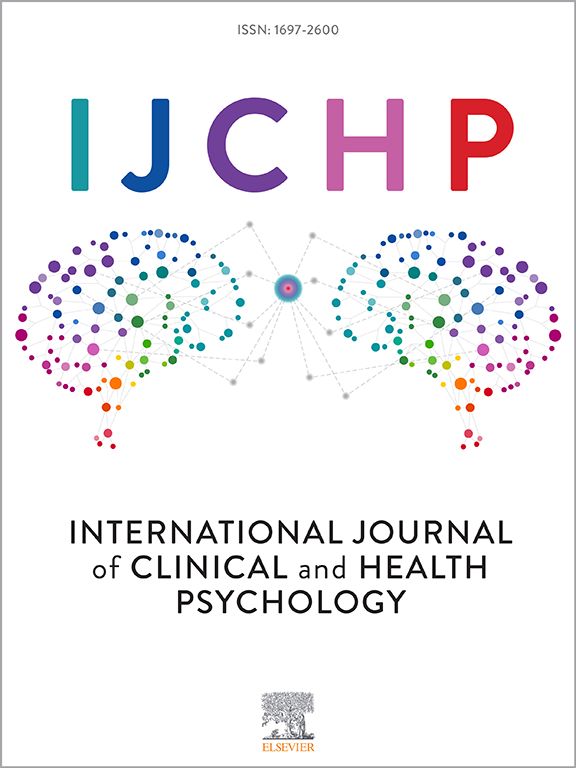焦虑性抑郁症患者的外周促炎细胞因子水平与脑结构萎缩有关
IF 4.4
1区 心理学
Q1 PSYCHOLOGY, CLINICAL
International Journal of Clinical and Health Psychology
Pub Date : 2025-10-01
DOI:10.1016/j.ijchp.2025.100629
引用次数: 0
摘要
背景:危险型抑郁症(AD)是重度抑郁症(MDD)的一种常见的神经生理亚型,常伴有免疫失调和脑结构体积改变。然而,炎症标志物与AD患者脑结构变化之间的内在关系尚不清楚。方法根据年龄、性别和受教育程度将参与者分为三组:AD组(n = 43)、非焦虑性抑郁组(NAD, n = 68)和健康对照组(HC, n = 53)。测定各组血清白细胞介素-1β (IL-1β)、白细胞介素-6 (IL-6)和肿瘤坏死因子α (TNF-α)水平。所有参与者都接受了t1加权磁共振成像(MRI)扫描,并进行了基于体素的形态测量(VBM)分析,以评估灰质体积(GMV)。进行相关性分析以调查AD组炎症标志物与GMV之间的潜在关联。结果与hcc患者相比,MDD患者血清IL-6水平显著升高。此外,与NAD组和HC组相比,AD患者表现出右侧壳核、右侧颞上回(STG)和右侧楔叶的GMV减少。值得注意的是,在AD组中,右侧STG GMV的降低与血清IL-1β水平和抑郁严重程度显著相关。结论这些发现为该MDD亚型的病理生理机制提供了初步的心理放射学证据,并可能解释AD和NAD在临床特征和预后方面的差异。本文章由计算机程序翻译,如有差异,请以英文原文为准。
Peripheral pro-inflammatory cytokine levels are associated with brain structural atrophies in patients with anxious depression
Background
Anxious depression (AD), a common neurophysiological subtype of major depressive disorder (MDD), is often accompanied by immune dysregulation and volumetric alterations in brain structures. However, the intrinsic relationships between inflammatory markers and brain structural changes in AD patients remain unclear.
Methods
Participants were categorized into three groups: the AD group (n = 43), the non-anxious depression group (NAD, n = 68), and healthy controls (HC, n = 53), matched for age, sex, and education level. Serum levels of interleukin-1 beta (IL-1β), interleukin-6 (IL-6), and tumor necrosis factor alpha (TNF-α) were measured across the groups. All participants underwent T1-weighted magnetic resonance imaging (MRI) scans, and voxel-based morphometry (VBM) analysis was performed to assess gray matter volume (GMV). Correlation analyses were conducted to investigate potential associations between inflammatory markers and GMV in the AD group.
Results
Compared to HCs, patients with MDD exhibited significantly elevated serum IL-6 levels. Additionally, AD patients demonstrated reduced GMV in the right putamen, right superior temporal gyrus (STG), and right cuneus compared to both NAD and HC groups. Notably, reduced GMV in the right STG was significantly correlated with serum IL-1β levels and depression severity within the AD group.
Conclusions
These findings provide preliminary psychoradiological evidence for the pathophysiological mechanisms underlying this MDD subtype and possible explanations for the differences in clinical features and prognosis between AD and NAD.
求助全文
通过发布文献求助,成功后即可免费获取论文全文。
去求助
来源期刊

International Journal of Clinical and Health Psychology
PSYCHOLOGY, CLINICAL-
CiteScore
10.70
自引率
5.70%
发文量
38
审稿时长
33 days
期刊介绍:
The International Journal of Clinical and Health Psychology is dedicated to publishing manuscripts with a strong emphasis on both basic and applied research, encompassing experimental, clinical, and theoretical contributions that advance the fields of Clinical and Health Psychology. With a focus on four core domains—clinical psychology and psychotherapy, psychopathology, health psychology, and clinical neurosciences—the IJCHP seeks to provide a comprehensive platform for scholarly discourse and innovation. The journal accepts Original Articles (empirical studies) and Review Articles. Manuscripts submitted to IJCHP should be original and not previously published or under consideration elsewhere. All signing authors must unanimously agree on the submitted version of the manuscript. By submitting their work, authors agree to transfer their copyrights to the Journal for the duration of the editorial process.
 求助内容:
求助内容: 应助结果提醒方式:
应助结果提醒方式:


